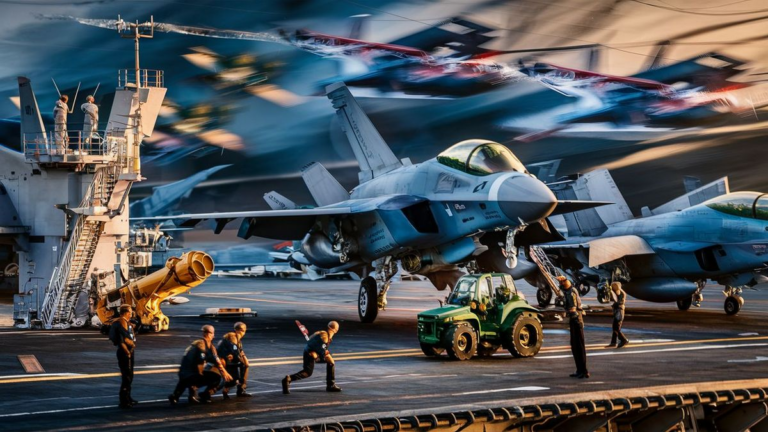When it comes to landing on an aircraft carrier, it’s not just a routine procedure; it’s a finely orchestrated ballet of precision, skill, and technology. Pilots and crew members undergo extensive training to execute this maneuver safely and effectively, ensuring the successful deployment and recovery of aircraft from these floating runways.
The Challenge of Landing on a Moving Deck
One of the most daunting aspects of landing on an aircraft carrier is the fact that the carrier itself is constantly in motion. The pitching and rolling of the deck, combined with the speed of the carrier, create a dynamic and challenging environment for pilots. It requires exceptional hand-eye coordination and split-second decision-making to line up with the deck and touch down smoothly.
Approach and Landing
The approach to landing on an aircraft carrier is a carefully choreographed sequence of events. Pilots must first establish proper altitude and airspeed as they prepare to enter the carrier’s landing pattern. As they approach the ship, they must make constant adjustments to account for the carrier’s motion and the changing winds.
Once in position, pilots rely on visual cues and guidance systems to align their aircraft with the deck. The Landing Signal Officer (LSO) provides critical feedback to the pilot, using a series of lights and signals to indicate their position relative to the desired glide path. It’s a high-stakes game of cat and mouse, where even the slightest deviation can have serious consequences.
Arrested Landing
As the aircraft makes contact with the deck, it must rapidly decelerate to a stop. This is achieved using a system of arresting wires, which are stretched across the deck and designed to catch a hook attached to the aircraft’s tail. The pilot engages the tailhook at the moment of touchdown, allowing the arresting wires to safely bring the aircraft to a halt in a matter of seconds.
Arrested landings require precise timing and coordination between the pilot and the deck crew. Any miscalculation or malfunction could result in a missed arrestment or, worse, a crash on the deck.
Training and Preparation
Given the complexity and risk involved in landing on an aircraft carrier, pilots undergo extensive training before attempting their first carrier landing. This includes simulated landings in a training environment, as well as practice sessions on land-based mock-ups of carrier decks.
In addition to technical skills, pilots must also develop the mental discipline and resilience to handle the pressure of carrier operations. The ability to stay calm and focused under stress is essential for safely executing a carrier landing, especially in adverse weather conditions or during combat operations.
Continuous Improvement
Even experienced carrier pilots are constantly refining their skills and techniques to improve their performance. After each landing, pilots undergo debriefings to analyze their approach and identify areas for improvement. This culture of continuous learning and self-improvement is essential for maintaining the highest standards of safety and proficiency.
As technology advances and new aircraft are introduced, carrier landing techniques may evolve, but the fundamental principles of precision and discipline will always remain the foundation of this demanding skill.
Landing on an aircraft carrier is a test of skill, nerve, and teamwork. It requires pilots to perform at the highest level under challenging conditions, relying on their training, experience, and the support of their fellow crew members. By mastering the art of carrier landings, pilots ensure the success of naval aviation missions around the world.
Frequently Asked Questions
Here are some commonly asked questions about landing on aircraft carriers:
| Question | Answer |
|---|---|
| 1. How fast does an aircraft carrier move during landings? | Typically, an aircraft carrier moves at speeds ranging from 20 to 30 knots during landings. |
| 2. How do pilots adjust for carrier motion? | Pilots make constant adjustments to their approach, accounting for the carrier’s motion and changing winds, using visual cues and guidance systems. |
| 3. What happens if the arresting wires malfunction? | If the arresting wires malfunction, it could result in a missed arrestment or a potential crash on the deck, highlighting the critical importance of this system. |
| 4. How do pilots train for carrier landings? | Pilots undergo extensive simulated landings in a training environment and practice sessions on land-based mock-ups of carrier decks to prepare for carrier landings. |
| 5. What is the role of the Landing Signal Officer (LSO)? | The LSO provides critical feedback to pilots during the approach and landing, using lights and signals to indicate their position relative to the desired glide path. |
Advanced Landing Techniques
Besides the conventional landing methods described earlier, there are advanced techniques employed in specific situations:
- Bolter: In the event of a missed landing, the pilot applies full throttle and performs a bolter, allowing them to abort the landing attempt and go around for another try.
- Wave-off: If conditions are unfavorable or the approach is deemed unsafe, the LSO can issue a wave-off command, prompting the pilot to abort the landing and try again later.
These techniques require additional training and skill to execute safely, adding to the complexity of carrier operations.
See also:






